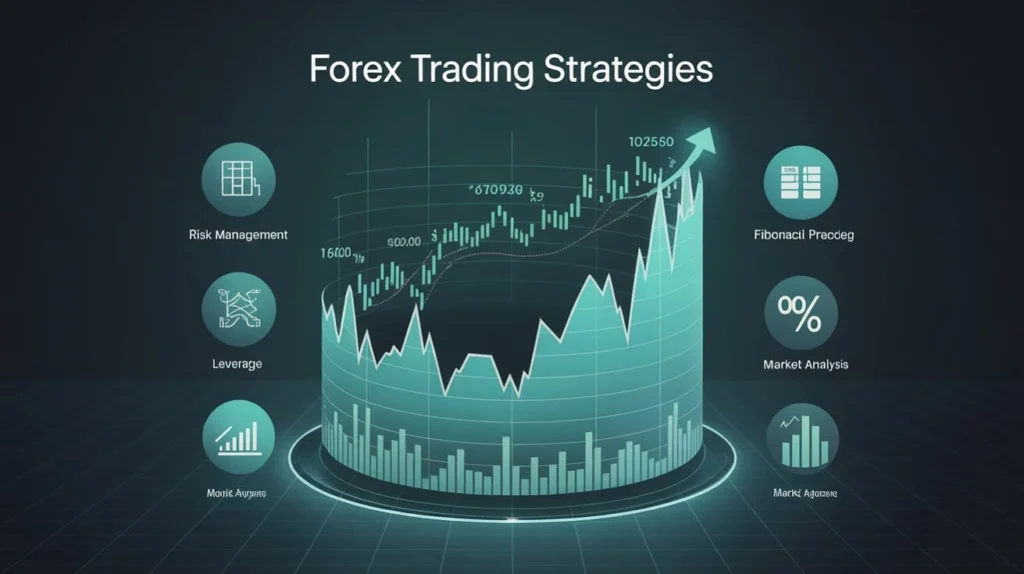Forex trading offers traders around the world the opportunity to participate in the largest financial market, where more than $7 trillion changes hands daily. But stepping into the market without a plan is like sailing without a compass. Whether you’re a novice or looking to sharpen your edge, understanding and applying effective forex trading strategies can be the difference between steady growth and costly missteps.

Content
What Is Forex Trading?
Forex trading, short for “foreign exchange company,” involves exchanging one currency for another to profit from price fluctuations. Traders speculate on whether a currency pair—like EUR/USD—will rise or fall in value. Unlike stock markets, the forex market operates 24 hours a day, from Monday to Friday, across global financial centers.
Why trade forex?
- High liquidity and tight spreads
- Low barriers to entry
- Leverage opportunities
- Multiple trading styles (day trading, swing trading, etc.)
Why Do You Need a Strategy in Forex Trading?
Trading without a strategy is like flipping a coin—random and unsustainable. A defined forex trading strategy helps you make informed decisions based on analysis, not emotion. It also gives you a consistent framework for:
- Entry points: Knowing when to initiate a trade
- Exit points: Knowing when to close a trade, win or lose
- Position sizing: Managing risk per trade
- Trade evaluation: Reviewing past trades to improve performance
The goal is not to win every trade, but to manage risk in a way that the profitable trades outweigh the losses over time.
Popular Forex Trading Strategies for Beginners
Whether you’re starting with $100 or $100,000, here are beginner-friendly forex trading strategies you can test and tailor to your trading style.
1. Trend Following Strategy
How it works: You follow the direction of the prevailing market trend. If the trend is up, you buy (go long); if it’s down, you sell (go short).
Key tools:
- Moving Averages (e.g., 50-day, 200-day)
- MACD (Moving Average Convergence Divergence)
- Trendlines and price action
Example: If EUR/USD is above the 200-day moving average and making higher highs, you wait for a pullback and enter a long trade.
2. Breakout Strategy
How it works: You enter a trade when the price breaks out of a defined support or resistance level with increased volume.
Key tools:
- Price channels
- Bollinger Bands
- Volume indicators
Example: USD/JPY has been consolidating between 147.00 and 148.50. Once price breaks above 148.50 with strong volume, a breakout trader goes long.
3. Range Trading Strategy
How it works: You identify currency pairs that are “trading sideways” and buy near support and sell near resistance.
Key tools:
- RSI (for overbought/oversold conditions)
- Stochastic Oscillator
- Support/Resistance zones
Example: GBP/USD is fluctuating between 1.2700 and 1.2900. A range trader might short at 1.2900 and take profit at 1.2750, setting a stop-loss above 1.2950.
4. News-Based Trading Strategy
How it works: Traders monitor key economic events and enter positions based on the expected impact of news such as interest rate decisions, employment data, and inflation reports.
Key tools:
- Economic calendar
- Real-time news feeds
- Volatility-based indicators
Example: If the U.S. Fed unexpectedly raises interest rates, the USD may strengthen rapidly. Traders position accordingly before or after the announcement based on their risk tolerance.
5. Scalping Strategy
How it works: Scalpers aim to make dozens (or hundreds) of small trades within minutes, profiting from minor price movements.
Key tools:
- 1-minute or 5-minute charts
- Tick volume indicators
- ECN broker with ultra-low spreads
Note: Scalping is not beginner-friendly unless you have a stable internet connection, lightning-fast execution, and iron discipline.
Choosing the Right Forex Trading Strategies
Selecting the right strategy isn’t just about profitability—it’s about personal compatibility. Ask yourself:
- How much time can I dedicate daily?
- Am I more technical (charts) or fundamental (economic news) focused?
- How do I respond to losses?
- Do I prefer slower trades (swing trading) or quick trades (scalping)?
Always backtest your strategy using historical data and demo accounts. Many brokers offer demo environments where you can simulate trades in real-time without risking capital.
Combining Strategies and Adapting Over Time
Experienced traders often combine multiple strategies or adjust them depending on market conditions. For instance, a trader may use a trend strategy during strong directional markets but switch to a range strategy during consolidations.
Key tips:
- Keep a trading journal to track performance
- Continuously review market conditions
- Update your risk parameters if your account grows/shrinks
- Never stop learning—from both wins and losses
Benefits and Risks of Forex Trading Strategies
Benefits:
- High liquidity: Easy entry and exit at almost any price
- Accessibility: Start with small capital
- Diverse trading opportunities: 80+ currency pairs
- Leverage: Control large positions with a small investment
Risks:
- Volatility: High potential for rapid gains—and losses
- Leverage risk: Amplifies both profits and losses
- Market complexity: Economic factors can change market direction quickly
Smart traders use forex trading strategies not just to chase profits but to mitigate these risks and survive long-term.
Choosing a Forex Broker to Support Your Strategy
The effectiveness of your strategy also depends on your forex broker. Look for:
- Regulation (FCA, ASIC, etc.)
- Tight spreads and low commissions
- Advanced platforms (e.g., MetaTrader, TradingView integration)
- Educational resources and real-time data access
A trustworthy broker ensures fair execution, access to analysis tools, and stable performance—crucial for strategy-driven trading.
Final Thoughts: Your Strategy, Your Success
Mastering forex trading strategies doesn’t happen overnight. It takes time, consistency, and a willingness to learn from both mistakes and wins. Start with one or two strategies, get familiar with their mechanics, and test thoroughly.
In the fast-moving world of forex trading, having a clear, well-practiced strategy is what separates the disciplined trader from the gambler. Invest in your learning, prioritize risk management, and adapt as the market evolves.
Frequently Asked Questions
What is the best forex trading strategy for beginners?
The best forex trading strategy for beginners is trend following. It’s simple to learn, uses clear indicators, and works well in trending markets.
How do I choose a forex trading strategy?
Choose a strategy based on your trading style, risk tolerance, and time availability. Start with one method, test it on a demo account, and adapt.

A business blog writer at the age of 19, Francis is a jack-of-all trades when it comes to writing. He specializes in content creation for businesses and blogs. With years of experience under his belt, he’s able to provide both written and video content that will engage readers and viewers alike!
